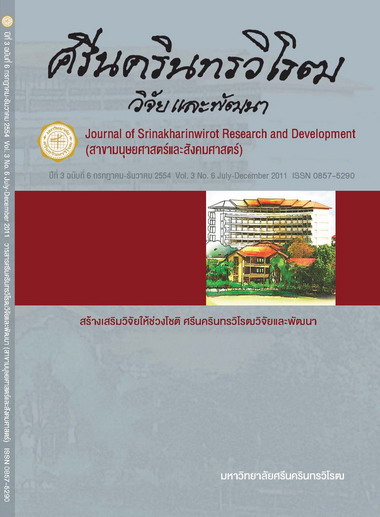ปัจจัยที่มีผลต่อพฤติกรรมการออมและการใช้จ่ายของผู้สูงอายุ (FACTORS AFFECTING SAVING BEHAVIOR AND SPENDING BEHAVIOR OF SENIOR CITIZEN)
Keywords:
Senior Citizen, Saving, Spending, Saving Behavior, Spending BehaviorAbstract
บทคัดย่อ การวิจัยครั้งนี้มีวัตถุประสงค์เพื่อศึกษาปัจจัยที่มีผลต่อพฤติกรรมการออมและการใช้จ่ายของผู้สูงอายุ รวมทั้งศึกษาความสัมพันธ์ระหว่างพฤติกรรมการออมและการใช้จ่ายของผู้สูงอายุ เพื่อเป็นแนวทางสำหรับทั้งภาคครัวเรือน ภาคธุรกิจเอกชน และหน่วยงานของรัฐ ให้สามารถนำผลที่ได้ไปใช้ในการวางแผนส่งเสริมให้เกิดการออมและการ ใช้จ่ายของผู้สูงอายุที่เหมาะสมต่อไป กลุ่มตัวอย่างที่ใช้ในการวิจัยครั้งนี้คือ ผู้สูงอายุที่มีอายุครบ 60 ปีบริบูรณ์ขึ้นไปอาศัยอยู่ในจังหวัดกรุงเทพมหานคร และมีการออมอย่างน้อย 1 ประเภท จำนวน 385 คน โดยใช้แบบสอบถามเป็นเครื่องมือสำหรับการเก็บรวบรวมข้อมูล สถิติที่ใช้ในการวิเคราะห์ข้อมูล ได้แก่ การหาค่าความถี่ ร้อยละ ค่าเฉลี่ย ค่าเบี่ยงเบนมาตรฐาน การวิเคราะห์ความแตกต่างโดยใช้การทดสอบค่าที การวิเคราะห์ความแปรปรวนแบบทางเดียว และค่าสัมประสิทธิ์สัมพันธ์สหแบบเพียร์สัน
ผลการศึกษาพบว่า ผู้สูงอายุที่ตอบแบบสอบถามส่วนใหญ่เป็นเพศหญิง ระดับการศึกษาสูงสุดต่ำกว่าปริญญาตรี อาชีพก่อนเกษียณอายุการทำงานเป็นข้าราชการ/รัฐวิสาหกิจ สถานภาพสมรส มีจำนวนสมาชิกในครัวเรือน 4-5 คน จำนวนผู้มีเงินได้ในครัวเรือน 1-2 คน แหล่งที่มาของรายได้ในปัจจุบันมาจากบุตร/หลาน รายได้ส่วนบุคคลเฉลี่ยต่อเดือน ต่ำกว่าหรือเท่ากับ 5,000 บาท เป็นผู้ไม่มีภาระหนี้สินแล้ว สำหรับผู้ที่ยังคงมีภาระหนี้สินอยู่ มีหนี้สินคงเหลือสูงกว่า 500,000 บาทขึ้นไป ด้านภาวะการทำงานส่วนใหญ่ไม่ทำงานแล้ว สำหรับผู้ที่ยังทำงานอยู่มีสถานะการทำงานเป็นลูกจ้าง ด้านภาวะสุขภาพผู้สูงอายุประเมินว่าตนเองแข็งแรงแต่มีโรคประจำตัว
ด้านข้อมูลเกี่ยวกับพฤติกรรมการออมของผู้สูงอายุพบว่า ส่วนใหญ่มีรูปแบบการออมในรูปสินทรัพย์ถาวรเป็นที่ดิน โดยผลรวมมูลค่าการออมในรูปสินทรัพย์ถาวรมีค่าเฉลี่ย 1,289,058.66 บาท และมีรูปแบบการออมในรูปสินทรัพย์ทางการเงินในระบบและนอกระบบเป็นเงินฝากกับสถาบันการเงินต่างๆ โดยผลรวมมูลค่าการออมในรูปสินทรัพย์ทางการเงินในระบบและนอกระบบมีค่าเฉลี่ยเท่ากับ 51,422.54บาท เหตุผลหลักในการออม คือ เพื่อไว้ใช้จ่ายในการเลี้ยงชีพ และวางแผนการออมในอนาคตว่ามีแนวโน้มจะออมเพิ่มขึ้น
ด้านข้อมูลเกี่ยวกับพฤติกรรมการใช้จ่ายของผู้สูงอายุพบว่า ส่วนใหญ่มีค่าใช้จ่ายเพื่อการดำรงชีวิตเป็นค่าใช้จ่ายด้านอาหารและเครื่องดื่ม โดยมีค่าใช้จ่ายเพื่อการดำรงชีวิตโดยเฉลี่ย 9,212.93 บาทต่อเดือน และค่าใช้จ่ายเพื่อความบันเทิง/พักผ่อนส่วนใหญ่เป็นค่าใช้จ่ายสำหรับกิจกรรมด้านสังคม โดยมีค่าใช้จ่ายเพื่อความบันเทิงพักผ่อนโดยเฉลี่ย 2,162.06 บาทต่อเดือน เวลาไปซื้อสินค้าและบริการมักไปกับบุตรหลาน สถานที่ที่ใช้จ่ายเงินบ่อยที่สุดคือ ห้างสรรพสินค้า และในช่วง 1 ปีที่ผ่านมาความถี่ในการซื้อสินค้าและบริการมีค่าเฉลี่ยโดยรวมในระดับน้อย
ผู้สูงอายุที่มีอาชีพก่อนเกษียณอายุการทำงาน และรายได้ส่วนบุคคลแตกต่างกันมีพฤติกรรมการออมในด้านมูลค่าการออมในรูปสินทรัพย์ถาวรแตกต่างกัน อย่างมีนัยสำคัญทางสถิติที่ระดับ 0.05 และผู้สูงอายุที่มี รายได้ส่วนบุคคลและภาระหนี้สินแตกต่างกันมีพฤติกรรมการออมในด้านมูลค่าการออมในรูปสินทรัพย์ทางการเงินในระบบและนอกระบบแตกต่างกัน อย่างมีนัยสำคัญทางสถิติที่ระดับ 0.05
ผู้สูงอายุที่มีระดับการศึกษา อาชีพก่อนเกษียณอายุการทำงาน สถานภาพสมรส จำนวนผู้มีเงินได้ในครัวเรือน รายได้ส่วนบุคคล และภาระหนี้สินแตกต่างกัน มีพฤติกรรมการใช้จ่ายในด้านค่าใช้จ่ายเพื่อการดำรงชีวิตแตกต่างกัน อย่างมีนัยสำคัญทางสถิติที่ระดับ 0.05 และผู้สูงอายุที่มีระดับการศึกษา อาชีพก่อนเกษียณอายุการทำงาน รายได้ส่วนบุคคล ภาวะการทำงาน และภาวะด้านสุขภาพแตกต่างกัน มีพฤติกรรมการใช้จ่ายในด้านค่าใช้จ่ายเพื่อความบันเทิง/พักผ่อนแตกต่างกัน อย่างมีนัยสำคัญทางสถิติที่ระดับ 0.05
นอกจากนี้พบว่า ปัจจัยด้านวัฒนธรรมในเรื่องความมีระเบียบวินัยมีความสัมพันธ์กับพฤติกรรมการออมของผู้สูงอายุในด้านมูลค่าการออมในรูปสินทรัพย์ทางการเงินในระบบและนอกระบบ และสัมพันธ์กับพฤติกรรมการใช้จ่ายของผู้สูงอายุในด้านค่าใช้จ่ายเพื่อการดำรงชีวิต อย่างมีนัยสำคัญทางสถิติที่ระดับ 0.05 และพบว่า ปัจจัยภายนอกมีความสัมพันธ์กับพฤติกรรมการใช้จ่ายของผู้สูงอายุในด้านค่าใช้จ่ายเพื่อการดำรงชีวิต อย่างมีนัยสำคัญทางสถิติที่ระดับ 0.05 พฤติกรรมการออมของผู้สูงอายุในด้านมูลค่าการออมในรูปสินทรัพย์ถาวรมีความสัมพันธ์กับพฤติกรรมการใช้จ่ายในด้านค่าใช้จ่ายเพื่อการดำรงชีวิต อย่างมีนัยสำคัญทางสถิติที่ระดับ 0.05 และพฤติกรรมการออมของผู้สูงอายุในด้านมูลค่าการออมในรูปสินทรัพย์ทางการเงินในระบบและนอกระบบมีความสัมพันธ์กับพฤติกรรมการใช้จ่ายทั้งในด้านค่าใช้จ่ายเพื่อการดำรงชีวิตและค่าใช้จ่ายเพื่อความบันเทิง/พักผ่อน อย่างมีนัยสำคัญทางสถิติที่ระดับ 0.05
Abstract
The purpose of this research are to study factors which affect to saving behavior and spending behavior of senior citizen as well as to study the relationship of saving behavior and spending behavior of senior citizen. The research results would be used as a guideline for promoting saving and suitable spending of senior citizen. The sample is 385 senior citizens in Bangkok who are 60 years old and above and have at least one kind of saving. The data is collected by using the questionnaires. Descriptive statistic methods used are percentage, average, standard deviation, Independent Sample t-test, One-Way Analysis of Variance and pair difference analyzed by Least Significant Difference (LSD) method and Pearson Product Moment Correlation Coefficient.
The results are shown as follows: Most of respondents are married female and have earned a degree lower than Bachelor’s degree. The last occupations were government officer/state enterprise employee. The household members are 4-5 persons but only 1-2 members have own income. The personal income of senior mainly earn from their children/grand children with an average monthly income of lower or equal to 5,000 Baht. Most of them have no liability. For the liable person, they remain the liability much more than 500,000 Baht. Most of respondents are retired worker but for those who are still working, they are employee. The respondents assess their health status that they are healthy but having congenital disease.
Regarding the saving behavior of most senior citizens are found that their fixed asset saving are the land. The average saving value of fixed asset is 1,289,058.66 Baht. For the financial asset saving, they have saving in many financial institutions. The average summation value of financial asset saving is 51,422.54 Baht. The main reason of saving is for supporting themselves. Moreover, they have a plan to save more in the future.
Regarding the spending behavior of most senior citizens are found that food and beverage spending is the main living spending with an average monthly spending of 9,212.93 Bath and social activity spending is the main entertainment spending with an average monthly spending of 2,162.06 Baht. Most of respondents usually go shopping with their children/grand children at the department store and had low frequency level to purchase products and services for the past year.
Senior citizens with different last occupation and average monthly income have different value of fixed assets saving at the statistical significant level of 0.05 and Senior citizens with different individual income and liabilities have different value of financial assets saving at the statistical significant level of 0.05.
Senior citizens with different in education level, last occupation, marital status, number of earned member in household, average monthly income and liabilities have different living spending at the statistical significant level of 0.05 and Senior citizens with different in education level, last occupation, average monthly income, working status and health status have different entertainment spending at the statistical significant level of 0.05.
Furthermore Cultural factor in self-discipline behavior of senior citizens has relationship both with value of financial assets saving and living spending at the statistical significant level of 0.05. External factors in government/business policy and Thai economy situation have relationship with living spending at the statistical significant level of 0.05. Value of fixed assets saving has relationship with living spending at the statistical significant level of 0.05 and Value of financial assets saving has relationship with both living spending and entertainment spending at the statistical significant level of 0.05.
Downloads
Downloads
Published
How to Cite
Issue
Section
License
Srinakharinwirot Research and Development Journal of Humanities and Social Sciences is licensed Under a Creative Commons Attribution-NonCommercial-NoDerivs 4.0 International (CC-BY-NC-ND 4.0) License, Unless Otherwise Stated. Please Read Journal Policies Page for More Information on Open Access, Copyright and Permissions.



